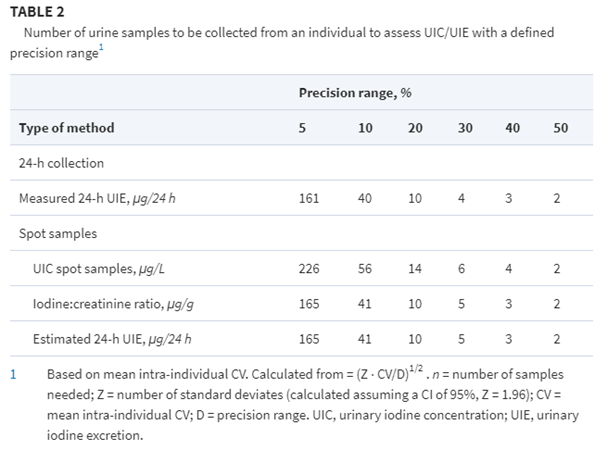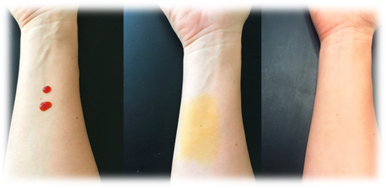Is iodine important? How much should you be getting? What kind of levels can help your thyroid? In this article, we are going to have answers to all of these questions and so much more. Consider this your comprehensive guide to iodine testing.
I want to walk you through all of the important elements, the things you absolutely should know, and the action steps you can take when it comes to iodine testing. Please, I hope you will join me on this exciting journey today.
The Essentials On Iodine
Before we go into a deeper dive, I wanted to share with you the ‘cliff notes’ version of this article. You may not have the time, or maybe you will come back to it later, but here is exactly what you need to know.
The first step you want to take the Iodine Inventory. This is a free online questionnaire that will give you a good gauge on your current nutritional status.
For those in a hurry, that’s the quick summary. For those who have the chance to stick around a bit longer, let’s get into it…
What Is Iodine All About?
If you are interested about learning more and diving into the world of iodine, it is something I have written about before and want to share with you!
Whether it is diving into large-scale studies around iodine (Read More: Denmark’s iodine experiment), the benefits of a low-iodine diet for your health (Read More: Discover the diet today), or how much iodine you need for thyroid disease (Read More: Iodine for your thyroid).
Each is its own deep dive into the realm of iodine, to help expand your understanding so that you can make the best decision possible for your health. I wish you nothing but happy reading!
What Are Common Iodine Measurements?
Let’s begin by thinking about how we measure iodine. First, you have your nutritional levels of iodine, which are a reflection of your daily intake over the recent past.
Then, we have your iodine balance. That is an indication of whether your thyroid is:
- Gaining iodine
- Staying steady
- Getting rid of excess
Why does all this matter? Because people all have a certain range of iodine that they can tolerate. Too little causes thyroid disease, too much causes thyroid disease, and way too much is simply toxic for your entire body.
How Do We Come Into Contact With Iodine?
If we need a better understanding of how to lower our iodine, and to keep it within a targeted range, we need to first assess all the ways we come into contact with it.
First, we ingest it. Our salivary glands, esophagus, and intestines all have ways to pump and pull in iodine. The lower we are in it, the more we pull it in.
And, the higher we are in iodine, the more we block it from getting in. That is just another level of control that we have that allows us to operate on a wider range.
We also get iodine in by breathing it! Usually not much, but if you live in a coastal area there can be some iodine in the air. Iodine also comes in through our skin, and into our bloodstream.
About 92% of the iodine we ingest through our mouths, we do assimilate and absorb it. And, approximately that same amount leaves through our urine.
How Should We Measure Iodine?
When we talk about measuring iodine, there are two “ways” of measuring that matter:
- For individuals
- For groups (populations)
Let’s start with the latter. There are a great deal of easy tests for iodine out there, but most of these can only see what a group has, on average, in terms of iodine load.
This means that, across a group, even if a handful of tests are way out of whack, the average remains consistent. This is great for group status and population studies.
But, this lacks the specific kind of results that we would need, as individuals. While it works well for public health groups to study populations, it may not work as well for our needs.
How Can You Test Iodine Levels?
Let’s investigate some of the ways we can currently test for iodine in our system. And, whether these are reliable in terms of testing…
Urinary Tests
The biggest testing tool, when it comes to iodine testing, is urine. For urine iodine tests, we have a spot urine test. This is typically one sample that may be reflective of the whole, but is only your level at merely one point in time. Another is a twenty-four-hour urine study.
We also have urine studies that are calibrated based on creatinine. Basically, one of the reasons that iodine can fluctuate is because your kidney activity can fluctuate. But, if you take into account how much creatinine was released, it can help account for those changes.
As always, the devil is truly in the details. Let’s take a look at the chart below…

In general, that is one of the main drawbacks of urinary tests more generally. You simply need to test and, at times, an incredible amount to get semi-reliable results.
Challenge Tests
Let’s consider this a subset of urine tests, but it deserves its own section here. Challenge tests have been used in three different contexts.
A study that was performed in 2013 was looking into how radioactive contrasts that had iodine, how long it took for that to get out of the body.
On average, what they found was that it took around 43 days.
The other way this test was used in 1992. Researchers were testing how quickly people, those with kidney disease, were able to get rid of iodine.
It turned out that it took them weeks and weeks.
Challenge tests have been used in functional medicine, with the thought that you could use a challenge dose of iodine to see how much iodine one might need.
Guiding Principle
Here’s the guiding principle: Your body would eliminate less iodine, if your body needed it, so if you took a big dose and you did not pee it all out, your body must have needed it.
Is this the case, though? It’s not really a valid premise. Think about mercury: it’s bad for you, but if you took a dose and it stayed inside it did not mean that your body ‘needed’ it.
Serum (Blood) Tests
Now, let’s get into what we call serum tests (which you may also know as blood tests). In general, these types of tests are good for toxicology purposes3.
If someone gets way too much iodine, their blood level can help us know if their symptoms are related to that extra iodine or something else.
But, your body works incredibly hard to keep iodine levels in your blood steady. So, it is only when you are completely out of control that it changes.
It also does not relate to your nutritional iodine status, at all. Only when you are at that toxic threshold. This wouldn’t happen save for some rather rare circumstances.
Thyroid Volume & Thyroglobulin
Thyroglobulin is the protein that your body uses to make thyroid hormone. When thyroid cells die and wear it, they spill a little thyroglobulin into the bloodstream.
Therefore, thyroglobulin is proportionate to thyroid cell death. And, it is kind of proportionate to thyroid size, at the same time.
Studies have also shown that both thyroid volume and thyroglobulin are inversely related to iodine intake (in populations).
So, across large groups of people, the more iodine they consume, the smaller their thyroid gets and lower their thyroglobulin goes.
However, people that have thyroid disease, there is no longer such a tight correlation here. While they are tests that have been talked about, they are only used in populations and do not really apply to those with thyroid disease.
Hair Testing
Some things do show up in the hair when excreted, and one paper proposed that hair markers could show an average intake over a couple of months.
While it did seem a bit appealing, the paper was retracted and the study was disavowed. While it exists, it really is not a valid tool.
Skin Level Testing
A popular idea has been that you can put a small amount of iodine on your skin, and if it disappears immediately the thought is that your body took it in and ‘wanted’ it.

So, what happens to iodine on your skin? Most of it becomes transparent, because it oxidizes and turns into iodide (which is clear in color).
The other portion evaporates into the air, so it simply goes away. We do absorb some, but the amount that we absorb does not relate to whether our bodies needed it or not.
So, What Testing Works?
If you’ve gotten this far and still need some clarity in terms of iodine testing, I want to help you.
Here is a quick breakdown of everything we covered and what you need to know for each iodine testing type:
- Urinary Tests – Super popular, but you need so many samples to get an even somewhat accurate reading.
- Challenge Tests – Not effective for individuals.
- Serum (Blood) Tests – Only if you’re toxic in iodine!
- Thyroid Volume – Meaningful in large group studies, but not as much on a person-to-person basis.
- Hair Testing – Not scientifically valid.
- Skin Testing – Also not accurate.
I hope that helps, but right now you might be thinking that a lot of testing simply doesn’t work. So, what kind of testing works?
Here is the answer you’re looking for…
And, What Test Works Best?
As of right now, there is no great testing tool for iodine to know your specific status. However, you can know that by using the iodine inventory quiz!
It is easy, free, and is completely non-invasive. Take it HERE
And, if you have already done a low-iodine regime and did not respond to it, then you can check urinary-iodine-creatinine ratio, and see what your iodine balance is.
What Do Your Scores Mean?
If you are below 99 mcg/G, you are effectively detoxing from iodine. That is the goal of the Thyroid Reset Diet. If you are above 100 mcg/G, you may still have some hidden sources of iodine.
Can Iodine Regulation Reverse Thyroid Disease?
Here’s the exciting part: One of the biggest studies showed that iodine regulation could reverse thyroid disease5.
In fact, 78.3% of people in the study had normal thyroid function within three months. But, let’s take a moment consider those that did not. What happens to them?
The remaining 21.7% who did not regain normal thyroid function were studied. They were divided into three groups:
- Their thyroid function was off by a huge amount, but it got way better if not best.
- They didn’t hit the ideal range and, therefore, didn’t have the chance.
- Their TSH didn’t move even with iodine changes (this was only one person!)
In short, this can help a lot. It can also help all people. And, if it doesn’t, you may have simply missed the mark in getting there all the way (so there is still hope).
After all, iodine levels do not predict who can be helped and who cannot be helped. Even if your iodine levels are low, you may have too much.
Iodine Testing: Summarized
While there are a lot of tests that are great, they are simply not accurate for individuals. The big one here is urine tests, which are used a lot, but you need a lot of results to have a fairly reasonable answer (and, even then, it may not be accurate).
Think about it like this: if you want to be within a 5% margin of error, which is still not a guarantee, you are going to need 200 samples!
That said, when you consider ways to reduce the iodine intake and to get into an ideal range, on the right regimen, results can exist and you can reverse the effects of thyroid disease.
Please, try the iodine calculator today to help you get started (Click Here: Take the test right now). After that, I hope you will join me on the journey to taking action steps for your health and feeling better today, tomorrow, and beyond!
Resources
2 – Source:Preedy V, Burrow G, et al. Comprehensive Handbook of Iodine. Elsevier. 2009. pg 426.
3 – (Jin, X., Jiang, P., Liu, L., Jia, Q., Liu, P., Meng, F., … Shen, H. (2017). The application of serum iodine in assessing individual iodine status. Clinical Endocrinology, 87(6), 807–814. doi:10.1111/cen.13421)
4 – Nyiri W, Jannitti M. About the fate of free iodine upon application to the unbroken animal skin. An experimental study. J Pharmacd Exp Ther. 1932;45:85-107.
5 – Kasagi K, Iwata M, Misaki T, Konishi J. Effect of Iodine Restriction on Thyroid Function in Patients with Primary Hypothyroidism. Thyroid. 2003;13(6):561-567. doi:10.1089/105072503322238827

P.S. Whenever you are ready, here is how I can help you now:
1. Schedule a complimentary consultation with one of my team of naturopathic doctors. This is a great starting point for assessing your unique health needs and treatment options.
2. Download and use my Favorite Recipes Cookbook Here
3. Check out my podcast Medical Myths, Legends, and Fairytales Here
Dr. Alan Glen Christianson (Dr. C) is a Naturopathic Endocrinologist and the author of The NY Times bestselling Adrenal Reset Diet, The Metabolism Reset Diet and The Thyroid Reset Diet.
Dr. C’s gift for figuring out what really works has helped hundreds of thousands of people reverse thyroid disease, lose weight, diabetes, and regain energy. Learn more about the surprising story that started his quest.



